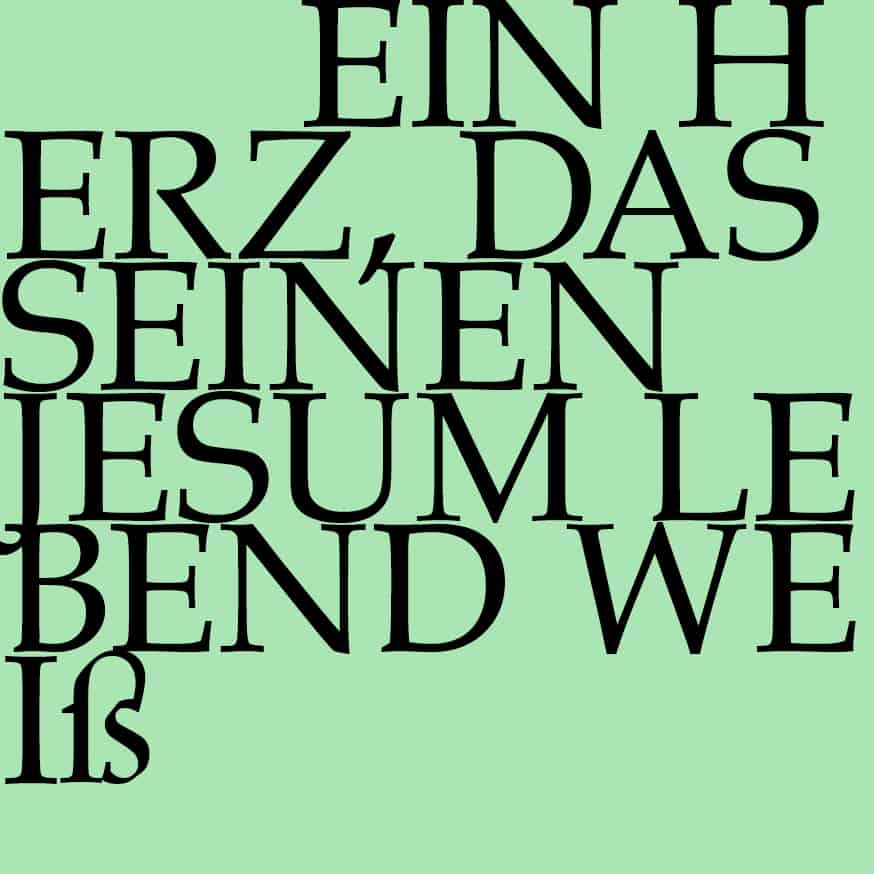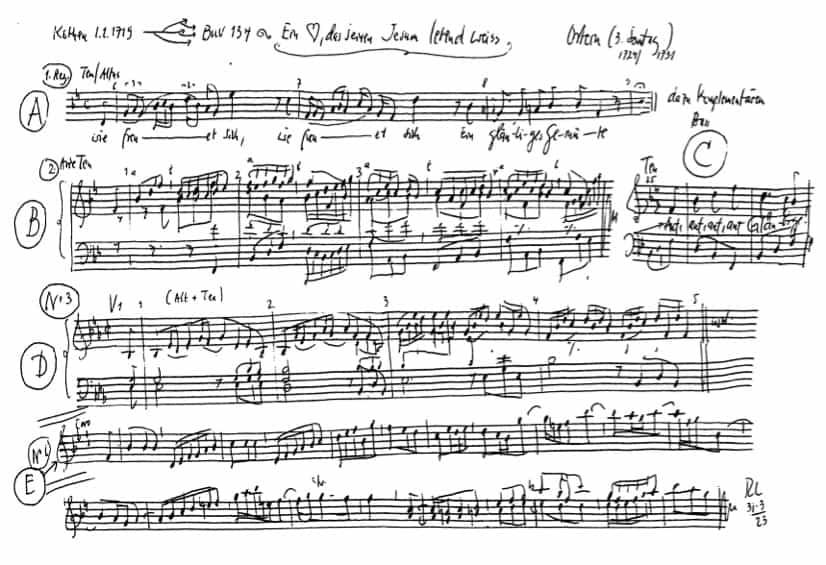Ein Herz, das seinen Jesum lebend weiß
BWV 134 // For the Third day of Easter
(A heart which doth its Jesus clearly know) for alto and tenor; vocal ensemble, oboe I+II, strings and basso continuo

Would you like to enjoy our videos ad-free? Subscribe to YouTube Premium now...
Workshop
Reflective lecture
Choir
Soprano
Lia Andres, Susanne Seitter, Maria Deger, Jessica Jans, Noëmi Tran-Rediger, Stephanie Pfeffer
Alto
Tobias Knaus, Antonia Frey, Alexandra Rawohl, Francisca Näf, Anne Bierwirth
Tenor
Clemens Flämig, Nicolas Savoy, Zacharie Fogal, Rodrigo Carreto
Bass
Daniel Pérez, Serafin Heusser, Jean-Christophe Groffe, Grégoire May, Retus Pfister
Orchestra
Conductor
Rudolf Lutz
Violin
Renate Steinmann, Patricia Do, Salome Zimmermann, Monika Baer, Elisabeth Kohler, Sólveig Steinþórsdóttir
Viola
Susanna Hefti, Claire Foltzer, Matthias Jäggi
Violoncello
Martin Zeller, Bettina Messerschmidt
Violone
Markus Bernhard
Oboe
Philipp Wagner, Laura Alvarado
Bassoon
Susann Landert
Harpsichord
Thomas Leininger
Organ
Nicola Cumer
Musical director & conductor
Rudolf Lutz
Workshop
Participants
Rudolf Lutz, Pfr. Niklaus Peter
Reflective lecture
Speaker
Georg Kreis
Recording & editing
Recording date
21/04/2023
Recording location
Trogen AR (Switzerland) // Evangelische Kirche
Sound engineer
Stefan Ritzenthaler
Producer
Meinrad Keel
Executive producer
Johannes Widmer
Production
GALLUS MEDIA AG, Schweiz
Producer
J.S. Bach-Stiftung, St. Gallen, Schweiz
Librettist
First performance
11 April 1724 – Leipzig
Text
Unknown source
Libretto
1. Rezitativ: Dialog — Alt und Tenor
Tenor
Ein Herz, das seinen Jesum lebend weiß, empfindet Jesu neue Güte
und dichtet nur auf seines Heilands Preis.
Alt
Wie freuet sich ein gläubiges Gemüte.
2. Arie — Tenor
Auf! Gläubige, singet die lieblichen Lieder,
euch scheinet ein herrlich verneuetes Licht.
Der lebende Heiland gibt selige Zeiten,
auf! Seelen, ihr müsset ein Opfer bereiten,
bezahlet dem Höchsten mit Danken die Pflicht.
3. Rezitativ: Dialog — Alt und Tenor
Tenor
Wohl dir, Gott hat an dich gedacht,
o Gott geweihtes Eigentum;
der Heiland lebt und siegt mit Macht
zu deinem Heil, zu seinem Ruhm
muß hier der Satan furchtsam zittern
und sich die Hölle selbst erschüttern.
Es stirbt der Heiland dir zu gut
und fähret vor dich zu der Höllen,
sogar vergießet er sein kostbar Blut,
daß du in seinem Blute siegst,
denn dieses kann die Feinde fällen,
und wenn der Streit dir an die Seele dringt,
daß du alsdann nicht überwunden liegst.
Alt
Der Liebe Kraft ist vor mich ein Panier
zum Heldenmut, zur Stärke in dem Streiten.
Mir Siegeskronen zu bereiten,
nahmst du die Dornenkrone dir,
mein Herr, mein Gott, mein auferstandnes Heil,
so hat kein Feind an mir zum Schaden teil.
Tenor
Die Feinde zwar sind nicht zu zählen.
Alt
Gott schützt die ihm getreuen Seelen.
Tenor
Der letzte Feind ist Grab und Tod.
Alt
Gott macht auch den zum Ende unsrer Not
4. Arie — Duett: Alt und Tenor
Wir danken und preisen dein brünstiges Lieben
und bringen ein Opfer der Lippen vor dich.
Der Sieger erwecket die freudigen Lieder,
der Heiland erscheinet und tröstet uns wieder
und stärket die streitende Kirche durch sich.
5. Rezitativ: Dialog — Alt und Tenor
Tenor
Doch würke selbst den Dank in unserm Munde,
indem er allzu irdisch ist;
ja, schaffe, daß zu keiner Stunde
dich und dein Werk kein menschlich Herz vergißt;
ja, laß in dir das Labsal unsrer Brust
und aller Herzen Trost und Lust,
die unter deiner Gnade trauen,
vollkommen und unendlich sein.
Es schließe deine Hand uns ein,
daß wir die Wirkung kräftig schauen,
was uns dein Tod und Sieg erwirbt,
und daß man nun nach deinem Auferstehen
nicht stirbt, wenn man gleich zeitlich stirbt,
und wir dadurch zu deiner Herrlichkeit eingehen.
Alt
Was in uns ist, erhebt dich, großer Gott,
und preiset deine Huld und Treu;
dein Auferstehen macht sie wieder neu,
dein großer Sieg macht uns von Feinden los
und bringet uns zum Leben;
drum sei dir Preis und Dank gegeben.
6. Chor
Erschallet, ihr Himmel, erfreue dich, Erde,
lobsinge dem Höchsten, du glaubende Schar.
Es schauet und schmecket ein jedes Gemüte
des lebenden Heilands unendliche Güte,
er tröstet und stellet als Sieger sich dar.
Georg Kreis
“Disputing Church”
Intermezzo for the performance of the cantata BWV 134 in the church of Trogen, 21 April 2023
The cantata offers what cantatas do: it combines a musical and a verbal composition. Text and sound form a unity. Nevertheless, the musical part is more likely to reach us. It is not easy to grasp the text, which Rudolf Lutz aptly describes as twisted, even though it is available in the programme and has been meticulously analysed in the introduction. Although much is meant metaphorically, the text is based on a martial understanding in the Baroque manner: enemies are fought, sacrifices have to be made, lives are at stake, but there is also the prospect of resurrection and victory. And in the midst of it all, there is talk of the Church at war. I want to tie my further reflections to this.
Instead of a disputing church, one would nowadays rather speak of a committed or confessing church and thus mean an attitude directed towards the outside, towards the external church society, although there can certainly also be disputes within the church. From an extremely peaceful attitude, strife is viewed negatively. Quarrels can be bad and should therefore be avoided, quarrels can be good and should therefore be conducted, quarrels are ambivalent. But it depends on what is being argued about and how. There are concerns that allow, indeed require, contentious advocacy. This is what those who claim to do so think and say.
This may only be an argument with words. As long as it does not simply turn into insults, it can refer to the fact that the argument shows who has the better arguments. But our source text wants more than a dispute with words, it expects a whole action, an existential commitment, a comprehensive readiness to fight that is so fundamental that – as in crusades – no distinction can be made between defence and attack. The higher the object of dispute is classified, the more justified the dispute and the fierceness of the engagement appear.
Willingness to fight for what? The answer to this question must take into account the fact that it is a question of the church‘s or, to be more precise, the churches’ ability to fight. What can the church consider itself responsible for and even obliged to do? This question has recently been discussed again in view of the corporate responsibility initiative. There were quite a few who wanted to support this political initiative not only privately, but also as members of the church congregation, because it wants to prevent “that people continue to be mistreated and that God’s creation continues to be exploited”. [1]
However, it was argued from another side – also in dispute – against such a commitment, that one should confine oneself to higher-ranking values that “directly” concern the faith, that one should not engage in activism in day-to-day political issues, which would only divide the Church and disparage the opponents of the bill as well as the opponents of the Church’s commitment in this matter as un-Christian.
In the second half of the 18th century, the great poet Gotthold Ephraim Lessing wrote two parables on the disputability of the Church and the religions (1778/79). In the better known, the Ring Parable, he postulates the fundamental equality of the three monotheistic religions, in historical order: Judaism, Christianity and Islam. However, he calls on the members of these faiths to show by their concrete behaviour that they represent the “right” religion. In the lesser-known palace parable, it is said of the palace that it is of “immense extent” but of “disputed” (!) architecture, therefore a little incomprehensible from the outside, but full of light and coherence on the inside. A façade with doors and gates “of various shapes and sizes”. He continues: “It was not understood why so many and various entrances were necessary, since a large portal on each side would be more appropriate and would do the job.
And again literally, because it is central to the parable: “And so many a dispute (!) arose among the supposed connoisseurs, which was generally conducted most heatedly by those who had had the least opportunity to see much of the interior of the palace”. It was believed that this dispute (!) could be settled quickly, because it was thought that one could refer to the old ground plans of the first palace builders.
Once upon a time,” as the story of the play goes, “the fire alarm was sounded at midnight. Then all the supposed connoisseurs reached for their floor plans, which were more important to them than the palace itself, and, looking at their plans, argued among themselves over the question of where the fire had broken out. Fortunately, however, it was a false alarm. The guards had, it is said, mistaken a northern light for a conflagration. Lessing: “Over these busy wranglers, then, it really could have burned down, the palace, if it had burned.”
Lessing calls on us to concentrate on the inside of the palace and to accept that there are different approaches. What is essential, however, remains open in the parable because it cannot be determined lightly or perhaps not at all. Different approaches: This is a commitment to pluralism (avant la lettre). According to today’s insights, pluralism is a necessary prerequisite for creative productivity. What turns out to be good and less good, however, is a question of measure. As positive and productive as pluralism is, it can also be blatantly conflict-laden if the diverse convictions are made absolute. Because faith tends to understand one’s own conviction as the only correct one, the pursuit of truth paradoxically produces a diverse reality.
Lessing’s palace parable was written in a dispute (!) with the Hamburg chief pastor Johann Melchior Goeze, the most important representative of Lutheran orthodoxy at the time, guardian of “pure doctrine” against liberal understandings of religion. This dispute was about the correct understanding of common Christianity, on which there were different views. In the meantime, we have to think more broadly about the issue. Today, more than ever, we are challenged to deal with the most diverse systems of conviction, not only religious but also secular. In doing so, we should not simply give up our own positions, if they exist, but we should also respectfully deal with other positions and, in the spirit of ecumenical, worldwide cooperation, keep the common good in mind – and work constructively to promote it.
[1] https://www.sachdokumentation.ch/bestand/ds/2680 – https://journal-b.ch/artikel/konzernverantwortung-und-die-kirchen/



